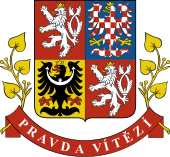Coat of arms of the Czech Republic
| Greater coat of arms of the Czech Republic |
|
|---|---|
 |
|
| Versions | |

Presidential version with the motto used on Czech Presidential Standard
|
|
| Details | |
| Armiger | Czech Republic |
| Adopted | 17 December 1992 |
| Escutcheon | Quarterly: first and fourth gules, a lion rampant queue forchée argent armed, langued and crowned Or (Bohemia); second azure, an eagle displayed chequé gules and argent armed, langued and crowned Or (Moravia); third Or, an eagle displayed sable armed and langued gules crowned of the field and charged on the breast with a crescent terminating in trefoils at each end with issuing from the centrepoint a cross patée argent (Silesia). |
| Motto | PRAVDA VÍTĚZÍ |
| Lesser coat of arms of the Czech Republic |
|
|---|---|
 |
|
| Versions | |

Version used by the Chamber of Deputies
|
|
| Details | |
| Armiger | Czech Republic |
| Adopted | 17 December 1992 |
| Escutcheon | a lion rampant queue forchée argent armed, langued and crowned Or (Czech lands) |
The coat of arms of the Czech Republic (Czech: Státní znak České republiky) displays the three historical regions—the Czech lands—which make up the nation. The current coat of arms, which was adopted in 1992, was designed by Czech heraldist Jiří Louda.
Bohemia and whole Czech lands
The arms of Bohemia show a silver double-tailed lion on a red background. This Bohemian Lion makes up the first and the fourth quarters of the greater coat of arms, so it is repeated in the shield. The Moravian red-and-silver chequered eagle is shown on a blue background. Between 1915 and 1918 the Moravian Eagle was chequered in the red-and-gold colors. The arms of Silesia are a black eagle with the so-called "clover stalk" (lat. perisonium) in her breast on a golden background, although only a small south-eastern part of the historical region (Czech Silesia) belongs to the Czech Republic (the main part is now in Poland).
The dukes (later kings) of Bohemia originally bore for arms a chequered black and gold eagle. In the 12th century, Emperor Frederick granted new arms to King Vladislaus II consisting of a silver lion on a red field, to symbolise his valor. The lion was at first represented with its tail between its legs, causing the people of Bohemia to laugh at it, calling it an ape. Upon hearing this, the Emperor jokingly decreed that the lion should henceforth be represented with two tails and a golden crown, and it has been shown as such ever since.
The oldest surviving full color depiction of the arms of Bohemia appears in the Passional of Abbes Cunegund from the 1310s. The Moravian Eagle was first documented on the seal of Ottokar's uncle, Margrave Přemysl (d. 1239). The Silesian Eagle stems from the ruling dynasty of the Piasts and was first applied by Duke Henry II the Pious (1238-1241). The shields also appeared on the emblems of the Crown of Bohemia established by Emperor Charles IV.
...
Wikipedia
